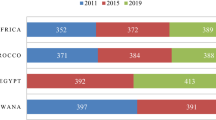Abstract
Information and Communication Technology (ICT) offers the potential for changing mathematics education for both teachers and students. However, how ICT is used, and by whom, is critical to realizing this potential. This paper reports on an investigation of the use of ICT in the learning and teaching of mathematics in rural and urban primary schools in Victoria, Australia. Thirty-six teachers and almost 700 students were surveyed regarding their use of ICT for mathematics at home and at school, with a small number of selected teachers and students taking part in interviews. This paper focuses on students’ perceptions of ICT use. A comparison of rural and urban students’ responses shows little difference across most aspects of ICT use, and where there was a difference, the frequency of rural use almost always exceeded that in urban schools.



















Similar content being viewed by others
Notes
RG1 refers to Rural Girl 1
References
Daher, W. (2010). Building mathematical knowledge in an authentic mobile phone environment. Australasian Journal of Educational Technology, 26(1), 85–104. Retrieved 1 December 2010 from http://www.ascilite.org.au/ajet/ajet26/daher.html.
Department of Education and Early Childhood Development DEECD (2009). Ultranet. Retrieved 21 May 2010 from http://www.education.vic.gov.au/management/ultranet/default.htm.
Department of Education, Employment and Workplace Relations DEEWR (2010a). The digital revolution: Overview. Retrieved 21 May 2010 from http://www.deewr.gov.au/Schooling/DigitalEducationRevolution/Pages/default.aspx.
Department of Education, Employment and Workplace Relations, DEEWR (2010b). Teaching teachers for the future. Retrieved 8 November 2010 from http://www.deewr.gov.au/Schooling/DigitalEducationRevolution/DigitalStrategyforTeachers/Pages/ICTInnovationFund.aspx.
Doig, B., & Groves, S. (2006). Easier analysis and better reporting: Modelling ordinal data in mathematics education research. Mathematics Education Research Journal, 18(2), 56–76.
Goos, M., & Cretchley, P. (2004). Computers, multimedia, and the internet in mathematics education. In B. Perry, G. Anthony, & C. Diezmann (Eds.), Research in mathematics education 2000–2003 (pp. 151–174). Flaxton: Post Pressed.
Groves, S. & Cheeseman, J. (1995). Beyond expectations: Using calculators with young children. In J. Wright (Ed.). Set: Research information for teachers. Number one, 1995. Item 3.
Groves, S., & Stacey, K. (1998). Calculators in primary mathematics: Exploring number before teaching algorithms. In L. J. Morrow & M. J. Kenny (Eds.), The teaching and learning of algorithms in school mathematics: 1998 yearbook of the National Council of Teachers of Mathematics (pp. 120–129). Reston: National Council of Teachers of Mathematics.
Higgins, S. E. (2010). The impact of interactive whiteboards on classroom interaction and learning in primary schools in the UK. In M. Thomas & E. C. Schmid (Eds.), Interactive whiteboards for education: Theory, research and practice (pp. 86–101). Hershey: IGI Global.
Hoyles, C., & Noss, R. (2009). The technological mediation of mathematics and its learning. Human Development, 52(2), 129–147.
Jamieson-Proctor, R., Burnett, P., Figner, G., & Watson, G. (2006). ICT integration and teachers’ confidence in using ICT for teaching and learning in Queensland state schools. Australasian Journal of Educational Technology, 22(4), 511–530.
Kissane, B. (2010). Technology, research and practice in mathematics education. Keynote address at the 33rd Annual Conference of the Mathematics Education Research Group of Australasia, Fremantle, WA.
Loong, E., Doig, B., & Groves, S. (In preparation). Primary teachers’ use of ICT in mathematics.
Masters, G. N. (1982). A Rasch model for partial credit scoring. Psychometrika, 47, 149–174.
McGaw, B. (2010). Finalising phase one of the Australian Curriculum. Australian Curriculum and Assessment Authority. Retrieved 2 January 2011 from http://www.acara.edu.au/verve/_resources/Statement_from_Barry_McGaw_Chair_of_ACARA_29th_October_2010.pdf.
Ministry of Education, Victoria. (1989). Reality in Mathematics Education: Activity bank (RIME Primary Mathematics). Melbourne: Ministry of Education.
O’Brien, T. C. (1983). Five essays on computers in education. The Phi Delta Kappan, 65(2), 110–112. Retrieved 7 November 2010 from http://www.jstor.org/stable/20386929.
Pannizon, D., & Pegg, J. (2007a). Enhancing student achievement in mathematics: Identifying the needs of rural and regional teachers in Australia. In J. Watson & K. Beswick (Eds.), Mathematics: Essential research, essential practice. Proceedings of the 30th annual conference of the Mathematics Education Research Group of Australasia (pp. 585–590). Adelaide: MERGA.
Panizzon, D., & Pegg, J. (2007b). Chasms in student achievement: Exploring the rural-metropolitan divide [online]. Education in Rural Australia, 17(2), 3–20. Retrieved 14 December 2010 from http://search.informit.com.au.ezproxy-m.deakin.edu.au/documentSummary;dn=287612265364606;res=IELHSS.
Papert, S. (1980). Mindstorms: Children, computers, and powerful ideas. New York: Basic Books.
Phillips, R. J. (1982). An investigation of the microcomputer as a mathematics teaching aid. Computers in Education, 6(1), 45–60.
Selwyn, N., Potter, J., & Cranmer, S. (2009). Primary pupil’s use of information and communication technologies at school and home. British Journal of Educational Technology, 40(5), 919–932.
Straker, A. (1987). The challenge to change: 1987 Presidential Address. The Mathematical Gazette, 71(457), 179–193. Retrieved 7 November 2010 from http://www.jstor.org/stable/3616759.
Tanner, H., Jones, S., Kennewell, S., & Beauchamp, G. (2005). Interactive whole class teaching and interactive white boards. In P. Clarkson, A. Downton, D. Gronn, M. Horne, A. Mcdonough, R. Pierce, & A. Roche (Eds.), Building connections: Research, theory and practice, Proceedings of the 28th annual conference of the Mathematics Education Research Group of Australasia (pp. 720–727). Melbourne: MERGA.
Trouche, L., & Drijvers, P. (2010). Handheld technology for mathematics education: Flashback into the future. ZDM—The International Journal on Mathematics Education, 42(7), 667–681.
Villarreal, M. E., & Borba, M. C. (2010). Collectives of humans-with-media in mathematics education: notebooks, blackboards, calculators, computers and … notebooks throughout 100 years of ICMI. ZDM—The International Journal on Mathematics Education, 42(1), 49–62.
Acknowledgments
This research was funded by the National Centre of Science, Information and Communication Technology, and Mathematics Education for Rural and Regional Australia (SiMERR) and a Research Development grant from the Faculty of Arts and Education, Deakin University.
Author information
Authors and Affiliations
Corresponding author
Rights and permissions
About this article
Cite this article
Loong, E., Doig, B. & Groves, S. How different is it really? – rural and urban primary students’ use of ICT in mathematics. Math Ed Res J 23, 189–211 (2011). https://doi.org/10.1007/s13394-011-0011-6
Received:
Revised:
Accepted:
Published:
Issue Date:
DOI: https://doi.org/10.1007/s13394-011-0011-6




